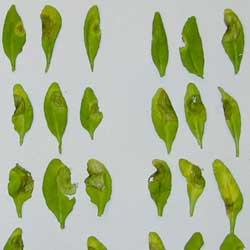Plants
During the past ten years, Ausubel lab has pioneered the isolation and characterization of Arabidopsis enhanced disease susceptibility (eds) mutants by direct screening, the first time that innate immunity had been subjected to rigorous and systematic genetic analysis in any eukaryotic organism. This work, as well as work from other labs, identified a variety of innate immune response pathways that regulate a multi-faceted immune response using salicylic acid (SA), jasmonic acid (JA), or ethylene (ET) as secondary messengers. Our primary goal, which has been accomplished was to identify defense-related pathways that function in parallel (or that intersect with) the previously identified SA, JA, and ET pathways.
 Specifically, we have produced a substantial body of both published work and preliminary results concerning signaling pathways that respond to a highly conserved 22 amino acid bacterial flagellar peptide called Flg22 or to oligogalacturonides (OGs) released from plant cell walls. A general hypothesis that we now propose to test is that among the characterized plant immune response pathways, the OG and Flg22 pathways are the most ancient and the most similar to the so-called “Toll-like” innate immune signaling pathways characterized in Drosophila and mammals. Specifically, we have produced a substantial body of both published work and preliminary results concerning signaling pathways that respond to a highly conserved 22 amino acid bacterial flagellar peptide called Flg22 or to oligogalacturonides (OGs) released from plant cell walls. A general hypothesis that we now propose to test is that among the characterized plant immune response pathways, the OG and Flg22 pathways are the most ancient and the most similar to the so-called “Toll-like” innate immune signaling pathways characterized in Drosophila and mammals.
An important unanswered question in the plant innate immunity field is how the Flg22 and OG pathways that respond to so-called non-specific pathogen associated molecular patterns (PAMPs) are related to the SA and JA/ET signaling pathways that primarily respond to pathogen-specific signals. We are using multiple approaches to further investigate the OG and Flg22 signaling pathways and, in collaboration with Jeff Dangl’s laboratory, to identify Pseudomonas syringae Type III effectors that disrupt or modify these pathways to enhance pathogen virulence.
1. Use molecular genetic and genomic methods to dissect the OG signaling pathway.
a. Use transient expression assays to identify components of MAPK cascade(s) activated by OGs.
 b. Determine whether OGs activate the same signaling pathways in protoplasts and intact plants. b. Determine whether OGs activate the same signaling pathways in protoplasts and intact plants.
c. Use whole-genome microarrays and custom patho-arrays, signaling mutants, kinetic analysis, and tissue specificity studies to elucidate the circuitry of OG-elicited defense response pathways (http://ausubellab.mgh.harvard.edu/nsf2010/index.jsp).
d. Test the hypothesis that genes that are specifically activated by OGs or Flg22 are only expressed in cells that are in direct contact with the elicitors.
e. Test the hypothesis that Botrytis cinerea and other pathogens specifically suppress the expression of particular OG (and Flg22)-activated genes.
f. Use reverse genetic analysis to determine the functions of selected OG pathway genes.
2. Use forward genetic analysis and genomic analysis to identify additional components of the OG signaling pathway(s) that function upstream (and downstream) of OG-activated MAP kinases.
3. Identify and characterize P. syringae type III effector(s) that block or modulate Flg22 and OG-activated MAPK signaling pathway(s) and/or the synthesis/exudation of antimicrobial compounds by roots (Collaboration with Jeff Dangl’s lab).
a. Develop high throughput assays for Type III effectors that block defense response pathways.
b. Screen a collection of 400-600 Type III effectors for ones that block defense response pathways.
c. Identify Type III effectors that block the synthesis/exudation of antimicrobial compounds from roots.
4. Identify signaling pathways that lead to the biosynthesis of antimicrobial compounds.
Enter the data from aims 1-4 in IMDS, a public, web-accessible relational database (http://ausubellab.mgh.harvard.edu/imds/).
|



 Specifically, we have produced a substantial body of both published work and preliminary results concerning signaling pathways that respond to a highly conserved 22 amino acid bacterial flagellar peptide called Flg22 or to oligogalacturonides (OGs) released from plant cell walls. A general hypothesis that we now propose to test is that among the characterized plant immune response pathways, the OG and Flg22 pathways are the most ancient and the most similar to the so-called “Toll-like” innate immune signaling pathways characterized in Drosophila and mammals.
Specifically, we have produced a substantial body of both published work and preliminary results concerning signaling pathways that respond to a highly conserved 22 amino acid bacterial flagellar peptide called Flg22 or to oligogalacturonides (OGs) released from plant cell walls. A general hypothesis that we now propose to test is that among the characterized plant immune response pathways, the OG and Flg22 pathways are the most ancient and the most similar to the so-called “Toll-like” innate immune signaling pathways characterized in Drosophila and mammals. b. Determine whether OGs activate the same signaling pathways in protoplasts and intact plants.
b. Determine whether OGs activate the same signaling pathways in protoplasts and intact plants.